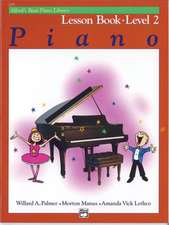The Piano-Forte: Its History Traced to the Great Exhibition of 1851
Autor Rosamond E. M. Hardingen Limba Engleză Paperback – 23 iul 2014
Preț: 285.89 lei
Nou
Puncte Express: 429
Preț estimativ în valută:
54.72€ • 59.46$ • 45.100£
54.72€ • 59.46$ • 45.100£
Carte tipărită la comandă
Livrare economică 21 aprilie-05 mai
Preluare comenzi: 021 569.72.76
Specificații
ISBN-13: 9781107418271
ISBN-10: 1107418275
Pagini: 528
Ilustrații: black & white illustrations
Dimensiuni: 153 x 230 x 35 mm
Greutate: 0.8 kg
Editura: Cambridge University Press
Colecția Cambridge University Press
Locul publicării:New York, United States
ISBN-10: 1107418275
Pagini: 528
Ilustrații: black & white illustrations
Dimensiuni: 153 x 230 x 35 mm
Greutate: 0.8 kg
Editura: Cambridge University Press
Colecția Cambridge University Press
Locul publicării:New York, United States
Cuprins
Preface; List of plates; List of abbreviations; Part I. The Pianoforte in the Eighteenth Century: 1. The invention of the pianoforte in Italy; 2. The invention of the pianoforte in France; 3. The invention and development of the pianoforte in Germany; 4. The tangent action and the cembalo stop; 5. The pianoforte in England; 6. Later developments in France; 7. The pianoforte in America; 8. The musical significance of the new instrument; Part II. The Pianoforte in the Nineteenth Century; Section 1. The Pianoforte as a Chamber Orchestra: 1. The pianoforte as a chamber orchestra; 2. Devices for the purpose of sustaining the tone; 3. Octave couplers and 'Duoclave' pianofortes; 4. The influence of programme music upon the pianoforte; 5. The influence of Turkish music upon the pianoforte; 6. Turkish music and other pedals; Section 2. The Pianoforte as a Solo Instrument in the Early Nineteenth Century: 1. The concert grand pianoforte; 2. Some improvements in the construction of the pianoforte relating to the production of a loud and sonorous tone; 3. The metal frame; 4. Pitch and temperament; Section 3. The Pianoforte as a Domestic Instrument: 1. The upright pianoforte; 2. Some other types of pianofortes in the home; 3. Pedal, transposing and self-acting pianofortes, experimental keyboards; 4. Tuning the pianoforte and apparatus for keeping the pianoforte in tune; Appendix A. Technical terms; Appendix B. Bibliography; Appendix C. List of patents; Appendix D. Concerning wire; Appendix E. Felt-making; tinder and sponge for hammer heads; process of tanning leather for hammer heads; Appendix F. Prices of pianofortes and of materials used in their manufacture; Appendix G. Select list of English pianoforte makers in London and its environs up to the year 1851; Appendix H. A note on pedal signs; Index.
Descriere
Originally published in 1933, this book provides a detailed history of the piano-forte.














